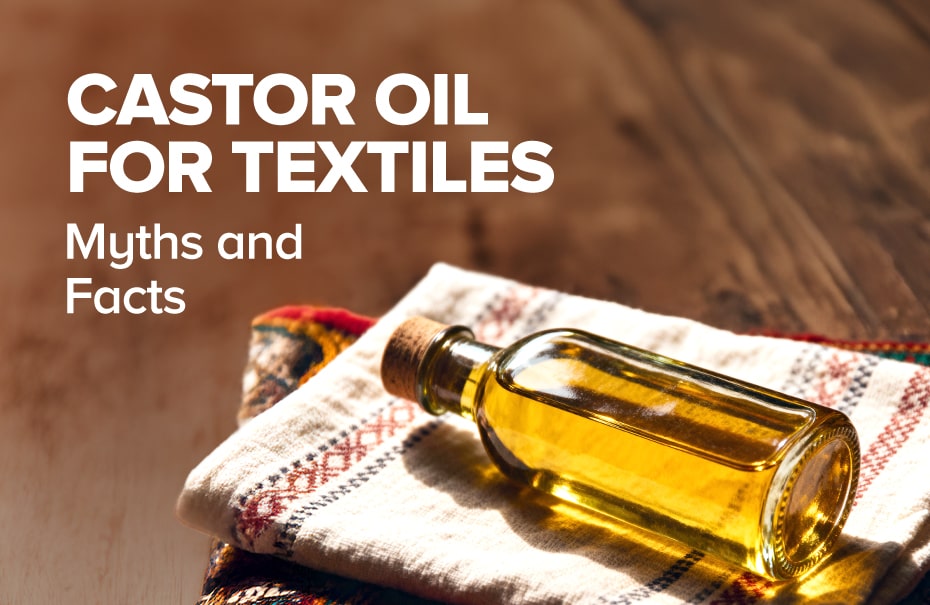Castor Oil for Textiles: Myths and Facts You Should Know

As the pace of the global textile industry moving to sustainability, performance improvement, and circular production has become high, a single bio-based input has gained interest among the value chain innovators: castor oil. Castor oil, once regarded as a niche industrial oil with limited usage, has also developed nowadays as a strategic raw material driving the next generation of textile chemicals, fibers, finishes, and performance materials.
However, in spite of this wave, there is still a lot of confusion. The myths that castor oil has more than what it is capable of doing continue to bother many businesses and designers, and even formulators.
Why Castor Oil Is Becoming a Game-Changer for the Textile Industry
The upsurge in the use of castor oil in the applications of the textiles industry is not a fashion but a technological change. The global castor oil market is currently estimated to be approximately USD 2.21 billion in the year 2024 and is projected to reach USD 2.33 billion in the year 2025, indicating the fast-growing significance of castor oil-based products in different industries, including the textile industry.
The rare chemical composition of castor oil, composed primarily of ricinoleic acid, is what enables it to provide industrial-grade polymers, high-performance derivatives, and a wide range of textile chemicals.
Today, castor oil is utilized in the following:
- Bio-synthetic synthetic fibers (such as polyamides of leading sportswear brands).
- Dye dispersants and carriers.
- Antistatic agents and softeners.
- Weaving and knitting oiling and lubrication compounds.
- Antimicrobial properties and hydrophobic finishes.
- Defense and industrial textile technical coating.
Nonetheless, despite the fact that it is being widely adopted, there are still a number of myths about castor oil. It is time to clear them with facts.
5 Myths and Facts of Castor Oil for Textiles
Myth 1: Castor Oil Only Belongs in Cosmetics or Medicine
Fact: Castor Oil is a High-performance Raw Material in Modern Textiles.
Traditionally, one of the most successful products in the pharma and beauty industry is castor oil, due to which people started believing that the industrial prospects of this product are minimal. The textile industry now, however, depends upon the derivatives of castor oil to furnish:
- Increased solubility and dispersion of dyes.
- Applied lubrication of fibers in spinning and weaving.
- Improved softness and drape.
- Manufacturing of lightweight, soft, and strong bio-based fabrics.
To illustrate, one of the well-known Indian manufacturers of hydrogenated castor oil, Ambuja Solvex, provides dyeing plants with highly stable materials that improve the homogeneity of pigments to a great extent, which states its key role in textile chemistry.
Myth 2: Castor-Oil-Based Textiles Lack Durability
Fact: Castor Oil Bio-Polymers tend to do better than Traditional Petroleum-based Materials.
One of the most enduring myths is durability issues. Nevertheless, bio-polyamides produced using castor oil (i.e., PA11 and PA610) are commonly known to:
- High tensile strength.
- Outstanding resistance to heat.
- High-quality elasticity and flexibility.
- Excellent abrasion resistance.
- Low moisture absorption.
This explains why major sportswear and outdoor brands are incorporating castor-oil polymer in activewear, backpacks, climbing gear, performance footwear, and protective apparel. These materials are manufactured to resist both extreme environmental and mechanical stress- this is usually stronger than conventional materials.
Myth 3: Castor Oil is Too Costly to be used for Large-scale Production
Fact: It Reduces Long-Term Processing Costs and Provides Sustainability Advantages.
The castor oil-related chemicals may be initially higher in cost than the petroleum-related inputs, but long-term operational and sustainability value is considerably greater. Benefits include:
- Reduced dye and chemical use through improved compatibility.
- Low processing temperatures.
- Less instability, i.e., fewer stoppages of the machine.
- Cut compliance expenses with green chemistry.
- Presence of global markets where bio-based and traceable supply chains are needed.
Myth 4: Castor-Oil-Based Chemicals are Incompatible with Modern Machinery.
Fact: Castor Oil Derivatives of High Purity are designed to be compatible with all.
The fear that processors have is that the castor-oil derivatives may not be compatible with the existing formulations and equipment. The answer is a definite yes.
Contemporary derivatives, including castor wax, hydrogenated castor oil, and ethoxylated castor oil, are developed to:
- Be able to maintain viscosity in high-temperature conditions
- Minimise foam during processing
- Enhance fiber lubrication
- Improve mechanical effectiveness in spinning, weaving, and knitting
- Minimize the residue of machines and improve the uniformity of dyes
Indicatively, major castor oil manufacturers in India, like Ambuja Solvex, offer high-performance castor wax to pigment printing units, which demand a high level of performance in terms of excellent melt stability and smooth application, a fact that shows its competence with high-performance textile systems.
Myth 5: Castor-Oil-Based Finishes Change the Feel or Appearance of Fabrics
Fact: They Significantly Enhance Softness, Smoothness, and Beauty.
The best quality of the castor oil-based finishing agents is the better handfeel. The advantages to textile processors are:
- Smoother surface finish.
- Increased non-greasy softness.
- Improved drape.
- Better fiber alignment.
- Less friction in the processing.
These attributes render castor oil derivatives perfect for high-end clothing, luxury fabrics, sportswear, household fabric, and top knitted material.
The Future: Why Castor Oil Will Continue to Transform the Textile Industry
The move towards bio-based alternatives is no longer a choice. As the environment grows increasingly strict, consumers favor green products, and as the world as a whole becomes more committed to sustainable sourcing, the textile industry is quickly transitioning to renewable chemistry.
Castor oil will further increase its role in the future due to the fact that it offers:
- Established industry performance.
- Low environmental footprint and traceability.
- Diversity in textile operations.
- Economical operations in the long run.
- Consistency with the global sustainability requirements.
This makes it one of the most promising and dependable bio-based inputs that will help the textile industry in the future.
Conclusion
With the growing significance of castor oil in all its textile applications, the selection of castor oil suppliers becomes a strategic decision. Purity, consistency, extraction techniques, and technical skills play a great role in the performance of the textile, whether in dyeing and finishing, fiber processing, or finishes.
This is where Ambuja Solvex comes in. Due to its quality, sustainability, and innovation, Ambuja Solvex provides high-grade castor oil product derivatives that textile-based manufacturers globally place their trust in. With the industry being more responsible and high-performance oriented, Ambuja Solvex remains committed to assisting businesses with the reliable and world-class solution of castor oil.
Castor oil is defining the next phase of textile development, and with the appropriate partner, the options are endless. Contact now for more details.
FAQs
- Why is castor oil useful in the textile industry?
The remarkable chemistry of castor oil is ideal in dyes, softeners, coatings, and performance fibers of the modern textile production that are bio-based.
- Is castor oil sustainable in textile applications?
Yes. Castor is a non-food crop that is drought-resistant and grows on marginal land; thus, it is one of the most environmentally friendly raw materials used in textiles.
- Do castor oil-based materials provide a comparable durability to petroleum-based ones?
Absolutely. Castor oil is a bio-polymer that is very strong, heat-resistant, and durable. It usually performs better than the traditional ones.
- Can castor oil derivatives co-exist with the current machinery in the textile industry?
Yes. The high-quality derivatives are mixed easily with the existing formulations, which makes them operate effectively in dyeing, finishing, spinning, and weaving systems.



